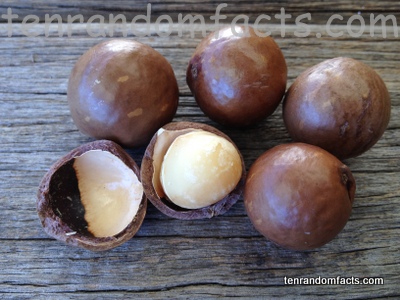Don’t be ‘a hard nut’. Add these macadamia nut facts to your collection.
- ‘Macadamia nuts’ are also known as ‘macadamias,’ Queensland nuts’, ‘bush nuts’, ‘queen of nuts’, ‘maroochi nuts’, and ‘bauple nuts’.
- Macadamia nuts are seeds that are from one of four species of macadamia tree, that are all native to Australia, in the eastern parts of northern New South Wales and southern and central Queensland.
- There are two species of macadamia nut that are poisonous, but the toxin, cyanogenic glycoside (cyanide), can be removed by parboiling the nut.
- Macadamia nuts have a very hard, woody, brown shell which reveals a cream coloured nut when cracked open, that turns golden brown when roasted.
- Macadamia nuts became known to the British by Alan Cunningham, a botanist from England, who discovered them in 1828 in Queensland.
- Australia is currently the top producer of macadamia nuts in the world, and the first trees grown, primarily for commercial purposes, were planted in an orchard in the 1880s, near Lismore, New South Wales, Australia.
- Macadamia nuts are cracked open when the nut is somewhat dehydrated, and to test for its readiness, the nut will usually rattle in the shell when it’s time, due to the nut growing smaller and detaching itself from the shell.
- Macadamia nuts are very high in thiamine, manganese and fat, and also contain quantities of many other vitamins and minerals.
- Some people are allergic to macadamia nuts, that can sometimes cause a fatal reaction, and they are also poisonous to dogs.
- Macadamia nuts are traditionally eaten raw or roasted, as well as being grounded into butter, covered in chocolate and included in nut mixes and baked goods, and the oil from the nuts is sometimes used in skincare products.
Bibliography:
Macadamia, 2014, Wikipedia, http://en.wikipedia.org/wiki/Macadamia
What are macadamia nuts?, n.d, WiseGEEK, http://www.wisegeek.com/what-are-macadamia-nuts.htm








